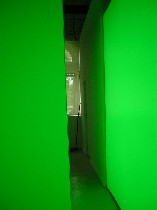 Standing in a translucent oval, the circling wall lit from behind by red, green and blue fluorescents programmed to create a variety of colors that morph seemlessly from one to the next, I pictured myself as a baby chick inside an egg being candled.
Standing in a translucent oval, the circling wall lit from behind by red, green and blue fluorescents programmed to create a variety of colors that morph seemlessly from one to the next, I pictured myself as a baby chick inside an egg being candled.
The glow and the space are the creation of Olafur Eliasson, the same artist who brought a faux sun room to the Tate Modern that became the must-see event of the London 2003-2004 winter season.
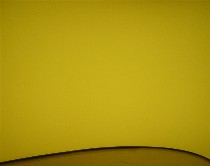 “Your colour memory,” Eliasson’s new piece showing at Arcadia University, first seduces with the voluptuous colors and then sneaks up with sensory and intellectual fallout (the original yellow is luminous, nothing like this dreary ochre in the photo!).
“Your colour memory,” Eliasson’s new piece showing at Arcadia University, first seduces with the voluptuous colors and then sneaks up with sensory and intellectual fallout (the original yellow is luminous, nothing like this dreary ochre in the photo!).
As someone taking pictures, I had the opportunity to compare what my eyes were telling me with what the camera suggested. There were discrepancies.
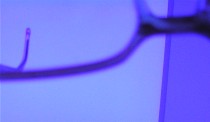 When the glow is green, the outside light looked pink to me . My camera showed otherwise(top, see window in distance is not pink). When the glow was blue, my eyeglass frames looked Day-Glo orange. My camera captured the moment but not the orange (right). When the colors shifted say from pink to yellow, a residue of pink stayed in my field of vision, mottling the yellow that was on the walls.
When the glow is green, the outside light looked pink to me . My camera showed otherwise(top, see window in distance is not pink). When the glow was blue, my eyeglass frames looked Day-Glo orange. My camera captured the moment but not the orange (right). When the colors shifted say from pink to yellow, a residue of pink stayed in my field of vision, mottling the yellow that was on the walls.
Eliasson’s point is that you, the viewer, are at the center of what this piece is. The piece itself offers you an experience, but that experience is what you make of it both consciously and unconsciously, with your senses and with your mind.
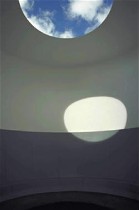 Eliasson acknowledges James Turrell and Robert Irwin as his heroes, but his work has a different purpose. Like Turrell, he created a hole in a roof, allowing the light from the sky to move across an interior space, but Turrell’s hole-in-the-roof pieces suggest transcendance. Eliasson’s hole cast a circle of light crossed by the shadow of metal beams–a more down-to-earth, less ethereal experience.
Eliasson acknowledges James Turrell and Robert Irwin as his heroes, but his work has a different purpose. Like Turrell, he created a hole in a roof, allowing the light from the sky to move across an interior space, but Turrell’s hole-in-the-roof pieces suggest transcendance. Eliasson’s hole cast a circle of light crossed by the shadow of metal beams–a more down-to-earth, less ethereal experience.
And like Irwin, Eliasson is concerned with how perception intersects with the reality, but again he brings is work down to earth often by revealing the works behind the illusion, or by making the viewer observe himself or his perceptions.
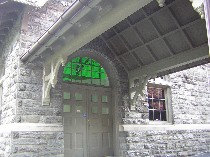 Part of the pleasure of “Your colour memory” is the way the colors interact with the building. There’s also the experience of walking into a black-out room behind a curtained door, and getting a rest from the intensity of the light.
Part of the pleasure of “Your colour memory” is the way the colors interact with the building. There’s also the experience of walking into a black-out room behind a curtained door, and getting a rest from the intensity of the light.
Rest of a different kind came on walking out of the installation into natural daylight. It was rather like walking out of an intense theatrical experience, after which the street looks drab and daily life looks even more ordinary than ususal.
A series of talks in conjunction with the installation looks quite interesting. Highlights include a talk by the artist on Sept. 13, and then there’s a talk by Dr. Oliver Sacks (neurologist and author of “The Man who Mistook his Wife for a Hat” and other books on perception phenomena). For more on these and other related events, go to the Arcadia link above.









